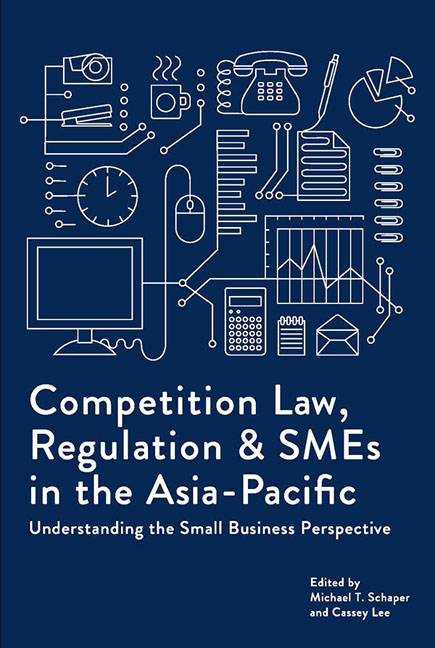 Competition Law, Regulation and SMEs in the Asia-Pacific
Competition Law, Regulation and SMEs in the Asia-Pacific Book contents
- Frontmatter
- Contents
- Foreword
- About the Contributors
- 1 Introduction: Making the Invisible SME More Visible in Competition Policy and Law
- Section 1 Theories And Basic Concepts
- Section 2 Smes And Competition Law
- Section 3 Country Studies
- 12 Competition Law, Regulation, and Trade: Implications for Productivity and Innovation in Singaporean Manufacturing SMEs
- 13 SME Law and Abuse of a Superior Bargaining Position in Japan
- 14 Competition Law, Policy, and Smes in South Korea
- 15 Competition Law Implementation and Smes: Singapore's Experience
- 16 Competition Law and SMEs in Indonesia
- 17 Smes and Malaysia's New Competition Law: Experiences to Date
- 18 Competition Policy and Sme Development in Vietnam
- 19 China's Anti-Monopoly Law and the Sme Sector
- 20 A New Competition Agency Learns to Deal with Smes: The Case of the Hong Kong Competition Commission
- 21 The Regulation of Television Programme Production Contracts under Japan's Subcontract Act
- 22 Small Enterprises and Competition Policy in Pacific Island Countries
- Index
12 - Competition Law, Regulation, and Trade: Implications for Productivity and Innovation in Singaporean Manufacturing SMEs
from Section 3 - Country Studies
Published online by Cambridge University Press: 05 August 2017
- Frontmatter
- Contents
- Foreword
- About the Contributors
- 1 Introduction: Making the Invisible SME More Visible in Competition Policy and Law
- Section 1 Theories And Basic Concepts
- Section 2 Smes And Competition Law
- Section 3 Country Studies
- 12 Competition Law, Regulation, and Trade: Implications for Productivity and Innovation in Singaporean Manufacturing SMEs
- 13 SME Law and Abuse of a Superior Bargaining Position in Japan
- 14 Competition Law, Policy, and Smes in South Korea
- 15 Competition Law Implementation and Smes: Singapore's Experience
- 16 Competition Law and SMEs in Indonesia
- 17 Smes and Malaysia's New Competition Law: Experiences to Date
- 18 Competition Policy and Sme Development in Vietnam
- 19 China's Anti-Monopoly Law and the Sme Sector
- 20 A New Competition Agency Learns to Deal with Smes: The Case of the Hong Kong Competition Commission
- 21 The Regulation of Television Programme Production Contracts under Japan's Subcontract Act
- 22 Small Enterprises and Competition Policy in Pacific Island Countries
- Index
Summary
This chapter explores the nexus between competition and productivity in the context of small and medium-sized enterprises (SMEs) in Singapore's manufacturing sector. Drawing on a study involving 215 in-depth surveys with SME leaders and managers, we explore questions of competition, regulation, and trade, and their implications for productivity and innovation. We find that there is considerable concern among SMEs that the market power of some large competitors is stifling efforts to enhance productivity and innovation. This suggests an important role for competition law and the competition regulator, the Competition Commission of Singapore (CCS), in boosting productivity and innovation. We also find that while SMEs support efforts to broker free trade agreements, they see a strong role for government in helping to identify the opportunities so generated and in building the capabilities needed to take advantage of these.
Introduction
This chapter considers the impact that competition law, regulation, and trade have on productivity and innovation among small and mediumsized enterprises (SMEs) in the manufacturing sector of Singapore. SMEs account for more than two-thirds of all employment, and 99 per cent of all businesses registered in Singapore (Department of Statistics Singapore 2014). Singapore's industrial and manufacturing focus has evolved since the founding of the Republic in 1965. Its industrial emphasis shifted from labour-intensive products that had limited value-added in the 1960s to export-oriented and semi-automated products in the 1970s. The 1980s saw the rapid expansion of the services sector, as well as a transition to high value-added manufacturing. However, over the past two decades, the share of the manufacturing sector in gross domestic product (GDP) has diminished, crowded out by a rapidly growing services sector. The manufacturing sector, and SMEs especially, have recorded weak total factor productivity (TFP) growth while maintaining a high dependence on foreign labour. Singapore has sought to explicitly address these challenges by raising productivity and wages of the resident labour force. As over two-thirds of the labour force is employed in SMEs, initiatives to increase the productivity of SMEs have received significant policy attention.
The chapter commences by explaining the rationale for the current productivity drive in Singapore and the importance placed on lifting the performance of SMEs. Following this, it examines the nexus between competition law, productivity, and innovation, paying particular attention to the key features of the competition law regime in Singapore.
- Type
- Chapter
- Information
- Competition Law, Regulation and SMEs in the Asia-PacificUnderstanding the Small Business Perspective, pp. 211 - 229Publisher: ISEAS–Yusof Ishak InstitutePrint publication year: 2016


